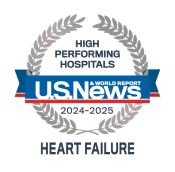Remote Heart Pressure Monitoring
It is important for people with heart failure to carefully monitor their heart condition. Cardiologists work with heart failure patients to help them maintain normal heart pressures and fluids. The challenge is that a patient may not know there is a problem until they start to show symptoms and by that point, hospitalization is often necessary.
Remote Monitoring for Heart Failure
The University of Maryland Medical Center is the first hospital in Maryland to offer patients special technology that allows doctors to monitor patients with heart failure without them leaving home. CardioMEMS is a remote sensor that measures the pressure in a patient’s pulmonary artery to help prevent worsening of heart failure.
CardioMEMS is FDA-approved and covered by insurance including Medicare. It is available to patients who have been hospitalized due to heart failure.
The sensor is inserted into one of the pulmonary arteries. The procedure takes a few hours and patients leave with a Band-Aid. The device is smaller than a dime and has tiny wires that stick to the artery walls. It has no battery and doesn’t need to be removed. CardioMEMS allows doctors to measure the elevation in a patient’s pressures two to four weeks before they show symptoms like shortness of breath.
How Does CardioMEMS Work?
To use it, the patient lies down on an external device that reads the signal from the sensor in their heart, which measures the pressure inside the pulmonary artery. That information is sent to their physician, who then adjusts the patient’s medication accordingly.
The monitoring is done by University of Maryland’s heart failure specialists, who work with patients to make adjustments. The patient’s regular doctor can view the levels and reports through UMMC’s web-based patient care network.
To learn more about the University of Maryland Medical Center’s remote heart monitoring program or to learn more, call 410-328-7877.

